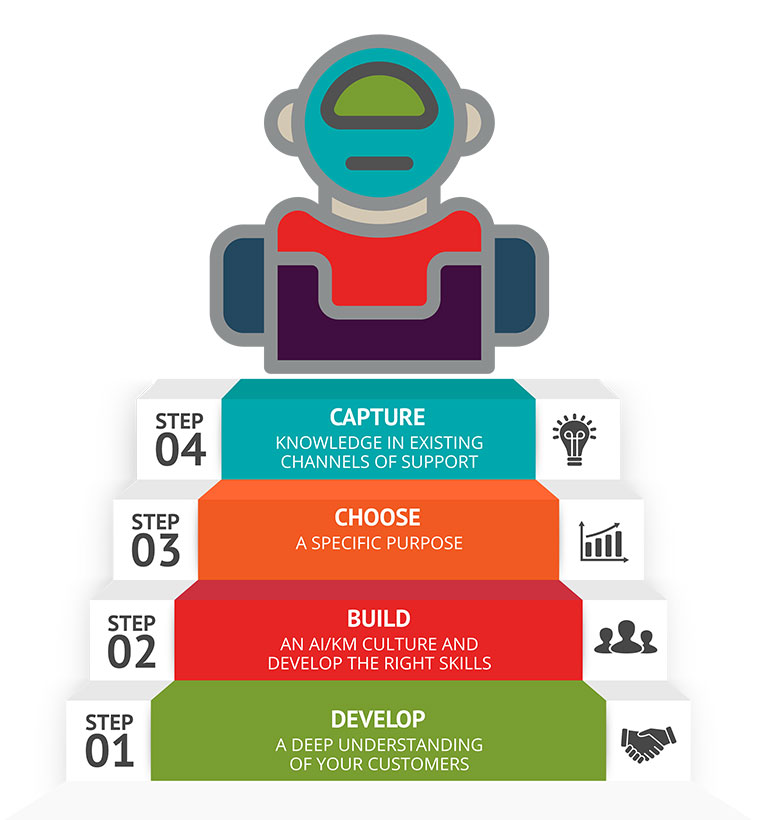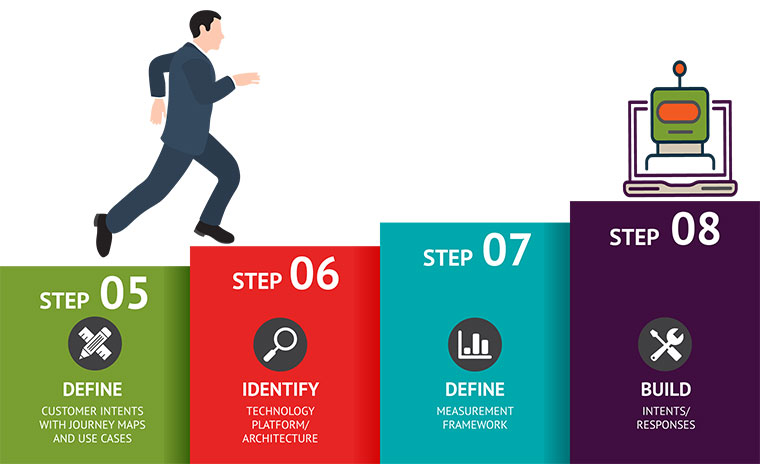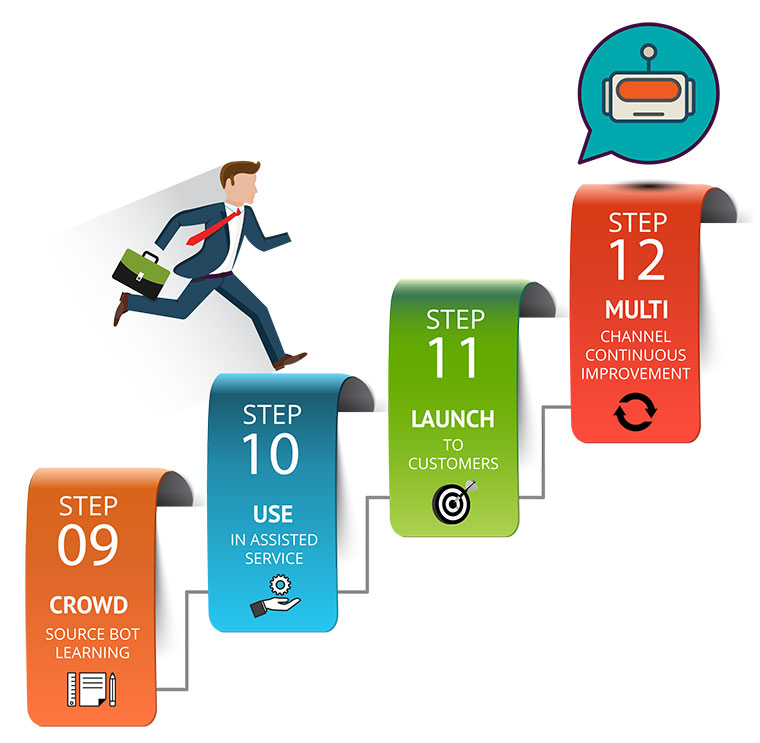Best of HDI in 2020 - #7
During the implementation of Sherlock, the knowledge chatbot, I learned a great deal about chatbots and the effort it takes to create a “conversation-like” interface that can successfully support customers. An adoption strategy must first identify the required customer-facing knowledge to program the bot effectively. Based on my experiences, I have developed a chatbot implementation strategy that you should consider before you jump into the world of bots.
Want to learn more about the role knowledge plays for your bot strategy? Join Julie for her session, Knowledge is Key to Implementing a Successful BOT Strategy, at SupportWorld Live.
Join us!

Step 1: Develop a Deep Understanding of Your Customers
A successful bot strategy must begin with first developing a deep understanding of your customers. What services are you providing today? Which products or services generate the most volume of interactions with customers? What type of interactions require the support of the organization? Most organizations do not lack data about customers and services and often have data collected from multiple channels. The difficulty is making sense of the data and being able to understand the customer experience across multiple channels.
Support often generates data from a multi-process, cross-functional delivery organization. In most cases, the data is not cohesively structured to provide insight into a single customer interaction that may span across multiple channels. Diving into data across the delivery organization and multiple channels will help to understand what the best approach will be when designing the bot. A successful strategy will seek to introduce a bot into the environment as part of an overall channel strategy. The goal is not to replace existing channels but instead to provide a succinct way for customers to interact with your business and get quick, accurate results. Additionally, the bot will need to meet your customers in their preferred channel. Don't guess where a bot can be successful; base your strategy on a deep understanding of the customer need.
Step 2: Build an AI/KM Culture and Develop the Right Skills
The goal of implementing a bot should be customer-focused, developing outcomes that are efficiently delivered to customers. As a result, the repetitive work typically requiring staff can now be successfully moved to the bot channel, where staff can be used for value-added work and transactions that have more complex exceptions. However, the intent should not be to replace staff. A bot can eliminate repetitive work, but humans are better at providing services and dealing with exceptions. The exceptions are where customers are won or lost and having a human who can best understand the complexity of the context of the transaction who can deliver a positive experience and exceed customer’s expectations.
Staff needs to understand that a well-trained bot can help them to work on more enjoyable work that is less repetitive. Their role evolves from managing customer interactions to using the bot to assist with gathering information and funneling exceptions quickly to staff who can better handle the exceptions that do not have explicit intents. Staff will also be essential to identify new intents and responses that, when added to the bot's programming, will improve the overall customer experience. It is not enough to just filter out the repetitive work and push it through a new channel. Staff needs to be focused on improving the learning of the AI systems and have the training necessary to shift their work processes from repetition to new skills and more in-depth knowledge.
Step 3: Choose a Specific Purpose
Developing a bot is much easier when you can narrow its purpose. A bot that answers technical questions is going to be significantly more challenging than a bot that can handle simple transactions such as a question and answer or request fulfillment. The more narrow the scope, the higher the likelihood that the bot will interact with humans successfully. Over time, the bot can be trained to provide additional services and more complex outcomes as the organization understands customer adoption and behaviors.
The main goal of your initial launch of the bot should be to provide consistency in responses, an additional touchpoint for customers that is flexible, responsive, and available 24x7. A bot conversation is much more inviting to customers than using a website. When a customer uses a website, the primary tool is to search and then determine what information in the search results provides the correct answer. A bot, on the other hand, provides a specific response based upon the customer's intent. The purpose of the bot should be to identify specific intents or conversations with customers and automate these using the bot. The goal is to get customers to an outcome as quickly as possible in a well-designed conversation. A narrow scope, in the beginning, will ensure early success for customers and a desire to use the tool again.
Step 4: Capture Knowledge in Existing Channels of Support
In many cases, the knowledge you need to build quality bot conversations with customers already exists in your support organization. The best place to start is with structured data captured in the relevant customer context. Gather data across multiple channels, including transcripts of chats in assisted support, recorded phone calls, and knowledge articles specifically written for use by customers.
The greatest opportunity in technical support is the transactional knowledge captured in the request fulfillment and incident management processes as well as general questions and answers. Using knowledge-centered service, focus on capturing the customer's context, which maps closely to the intent and the technical analyst's response, which maps closely to the responses. The organization's context provides the metadata to improve the intelligence of the bot to map the intents to the correct responses. If the knowledge you have captured today is effective for customers in self-service, it is ideal to use the knowledge to train the bot. While structured data is often the most widely used, don’t forget that unstructured knowledge can also be beneficial in understanding customers’ intents.

Step 5: Define Customer Intents with Journey Maps and Use Cases
An effective bot strategy must seek to provide a successful customer experience for the common use cases that are within the defined scope. In customer experience management, the mapping of customer journeys helps an organization to understand how to engineer a better overall experience that results in higher customer satisfaction and increased loyalty. The goal is not only to create an outcome using a bot as an alternative channel, but also to create an experience that delights your customers.
The goal is not only to create an outcome using a bot as an alternative channel, but also to create an experience that delights your customers.

Understanding customer intents—the identification of what a customer wants from an interaction with the support organization (requests, incidents, questions)—is crucial in developing successful conversations but also in helping to define an appropriate scope for the bot. Develop a subset of intents for the most relevant outcomes sought by your customers that make sense to deliver from a bot. Don’t try to introduce all customer intents, but instead a subset of intents that are well understood and well documented. A handful of well-defined use cases based upon customer journey maps and supporting transactional data and knowledge will be much easier to design and deliver than trying to map out all scenarios. Tackle the most common use cases first and then expand the scope of the bot as the organization learns from the experience.
Step 6: Identify Technology Platform/Architecture
You have probably heard this before, but don’t focus on the technology at the beginning. The most important thing to the successful adoption of a chatbot is understanding your customers and the type of knowledge that you need to serve them. If you do not have a good working self-service site today, the first step in your chatbot strategy likely is to address what is not working today so that you are just not adding another technology on top of the knowledge that doesn't work.
The technology platform is the least of your worries. Choose a platform that makes the most sense and one that can provide the user interface where your customers are most likely to use the bot. Most bot platforms provide integration with popular channels such as Facebook, Slack, and your website. But even more critical in the selection of your bot platform is the possible integrations you will need for the fulfillment of requests. While simple FAQs and knowledge pushed out to your customers is an obvious first step in utilizing this new platform, eventually, you may need to integrate the bot into existing ITSM or CRM tools where information about customers is automatically captured as a result of a successful outcome. At a minimum, you will want a platform that provides not just a dialog or interaction based upon pre-programmed rules. The use of artificial intelligence and natural language understanding are vital in the bot learning over time.
Step 7: Define Measurement Framework
While work to develop a bot is significant, your organization must also develop a measurement framework that includes measuring the success of the bot and measuring the success of the customer journey. A bot is just another channel of support that must be measured for its success in serving customers. However, developing a set of channel-based KPIs only gives a partial indication of success. A measurement framework must focus on understanding the success of the overall customer journey.
An important bot metric is based upon a successful outcome or completion rate. Traditional transaction type metrics in other channels will not be appropriate. For example, AHT (average handle time), MTTR (mean time to resolve), will not apply to a channel that can handle many different transactions at one time and where the transaction can take as long as needed for the customer to get the desired result. Tracking the rate of successful outcomes is an excellent start in understanding customer success.
Another metric to consider is the bounce rate or fallout rate. This metric tracks how often a customer bails from a chat with a bot to use another channel, or the customer is moved over to an exception path where human intervention is required. To understand customer adoption, another metric to consider is reuse rate or how often a customer returns to using the bot again after a successful outcome or result.
Remember, customers are likely to pick the path of least resistance, and this often means starting in one channel but may involve multiple channels until a successful conclusion is achieved. A customer may start in a self-service portal but then may use the bot and eventually need to call in to speak to a live agent. It is essential to understand why a visit to a website was not successful and what ultimately led to a call to a live agent. By studying the customer journey with click-stream analysis or digital tracing, the support organization can better understand the bot’s effectiveness in serving the customer, and exceptions can be used to improve service across all channels.
Step 8: Build Intents/Responses
The next step is to build the bot by developing the intents, responses, and customer contexts based upon the defined use cases. Each use case should map to a unique intent. For example, ordering a computer is a common request. The use case—how a computer is ordered today within the request fulfillment process—is used to build the underlying conversation that helps the customer to accomplish the outcome efficiently.
In this step, it is critical to have an in-depth understanding of how the conversation engine works in your chosen platform. Each intent or customer outcome will have questions, responses to questions, and also entities—facts or pieces of information that are needed to understand the specifics of the outcome.
For example, does the customer want a laptop, desktop, or mobile device? What operating system is required? The entities are built into additional follow-up intents. The input of one intent into another intent is an integral part of building a realistic conversation. Data from existing channels can provide significant visibility into how those conversations take place in existing channels and will provide breadth in adding multiple training phrases to the bot's initial intent development. It will also be important to identify points in the customer journey where the customer will fallout of the interaction and work with a staff member, an exception occurs, or when the desired outcome is reached. The journey maps, use cases, and data analysis of existing knowledge will support the development of well-defined intents and response.
Each of the intents requires testing to ensure that all paths work as intended, and any integration with systems outside of the bot platform is working properly.

Step 9: Crowd-Source Bot Learning
The bot will have a lower degree of accuracy and, thus, a lower containment rate at the beginning of the adoption. To ensure that customers are not subjected to the steep learning curve, additional testing by staff and select customers will improve the artificial intelligence and learning of the bot before launching to customers. The process is not entirely manual. Using the natural language understanding, the bot will learn to handle new phrases and map them to the existing intents. Alternatively, additional paths or intents may be identified and required before use directly by customers.
If possible, a short period of testing by a broad customer base will provide a lot of additional data to help the bot learn. Remember, it isn’t just about helping the bot to learn. The staff also need to practice their new responsibilities of monitoring the progress of the bot’s learning, identifying exceptions, and measuring its success.
Step 10: Use in Assisted Service
The final step prior to rolling out the bot to the customer is to use the bot in assisted support. What is the containment rate when used by a staff member when walking the customer through the intent in a different support channel such as phone or chat support? The goal is to improve the design of existing intents to ensure the results are being delivered successfully before launching to customers. Here is where the final tweaking occurs, and staff is supporting the bot development and practicing the skills needed to improve the bot continually.
Step 11: Launch to Customers
With the above-outlined level of planning, the organization can, with greater confidence, launch the new channel. Measurement is vital to understanding customer adoption, completion rates, fallout rates, and the impact on support volumes in other channels of support. Be sure to market the new service and celebrate the successful journey of launching a new service!
Step 12: Multi-Channel Continuous Improvement
While substantial work is required to get to a bot launch, remember that the work has just begun. To improve the bot, the staff need to identify additional intents, gather data, and repeat the process to increase the scope of the bot gradually over time. But continuous improvement should not focus on just the bot. Remember that a customer journey may cross many different channels. The organization must ensure that the underlying processes are consistent across channels, that the knowledge of intents and responses does not vary depending on the channel of support.
Keep Learning and Improving
As we wrap up our discussion on developing an effective chatbot strategy, it is important to note that artificial intelligence is an exciting, emerging field that can help us not only serve customers in new ways, but also provide incredible insight into the customer experience. The implementation process of the chatbot is relatively easy, and the tools have well-documented implementation guides. While adoption is easy, it will be essential to establish a strategy that will allow the organization to experiment with this emerging channel, learn from the experience, and develop a more comprehensive approach over time.
Please feel free to give Sherlock the experimental chatbot about knowledge a try. Your questions will be added to the Collective. If you have any questions, please feel free to contact me or connect with me on your preferred social networking platform.
Julie is a dynamic, engaging change agent who brings authenticity, integrity, and passion to practitioners worldwide. Through her books, articles, speaking, consulting, and teaching, her purpose is to spark change in the world with thought-provoking dialog and interaction on topics of authentic leadership, business strategy, knowledge management, organizational culture, and innovation. Julie has a B.S. in computer science from The Ohio State University and an MaED from the University of Phoenix and is currently pursuing her Ph.D. in Management and Organizational Leadership in Information Systems & Technology from the University of Phoenix. She is an ITIL Expert, Certified Help Desk Director, and Certified Governance IT Professional. She is an HDI Business Associate and teaches training and certification classes for service and support professionals. Visit her website, and follow her on Twitter @JulieMohr, YouTube, and LinkedIn.